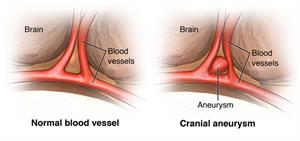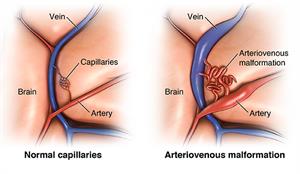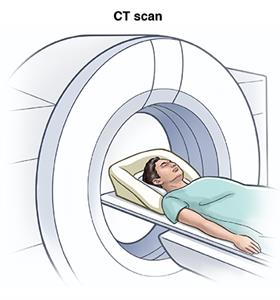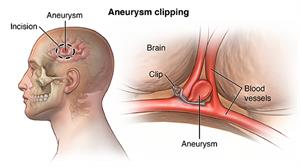Cerebral Aneurysm
What is a cerebral aneurysm?
A cerebral aneurysm is a bulge in a weak area of the wall of a brain artery. It puffs out like a small balloon. It is also called an intracranial aneurysm or brain aneurysm. The bulge is also known as a bleb. It makes the artery more likely to tear (rupture) in that spot.
A cerebral aneurysm more often happens in an artery under the front part of the brain. But arteries anywhere in the brain can get an aneurysm.
A normal artery wall is made up of 3 layers. The wall where the aneurysm forms is thin and weak. The weak area is caused by too little muscle in the artery wall. There are several types of aneurysms. They are:
Berry (saccular) aneurysm. This is the most common type of cerebral aneurysm. It looks like a berry with a narrow stem. More than 1 of these may occur at the same time.
Fusiform aneurysm. This type bulges out on all sides. This forms a dilated artery. This type is often linked to atherosclerosis.
Dissecting aneurysm. This type is caused by a tear along the length of the artery in the inner layer of the artery wall. Blood leaks in between the layers of the wall. This may cause 1 side of the artery wall to balloon out. Or it may block blood flow through the artery. This type of aneurysm usually happens from a traumatic injury. But they can also happen on their own.
Mycotic aneurysm. If bacteria spread in the blood, they can infect the artery wall. This weakens the wall and can turn into an aneurysm. More than 1 of these often occur at the same time. They are at higher risk of bleeding than other types. They are uncommon.
Most cerebral aneurysms don't cause symptoms. Most are small. They are less than 0.4 inches (10 millimeters) across. Smaller aneurysms may be less likely to break.
What causes a cerebral aneurysm?
Researchers don't fully know what causes cerebral aneurysms. They are linked to several things. These include:
Advanced age
Smoking
High blood pressure
Binge alcohol drinking
Being a woman
Family history of aneurysms
Polycystic kidney disease
The main cause of a brain aneurysm is a weakening in the wall of an artery. The pressure of the blood being pumped through the artery can then cause the bulge in that weak area. In certain areas, an aneurysm may have more pressure on it. For example, a place where the artery divides into smaller branches may have more pressure.
Who is at risk for a cerebral aneurysm?
You are more at risk for an aneurysm if you have 1 of the inherited problems below:
Alpha-glucosidase deficiency.This is a complete or partial lack of the enzyme needed to break down glycogen and to convert it into glucose.
Alpha 1-antitrypsin deficiency.This is a disease that may lead to hepatitis and cirrhosis of the liver or emphysema of the lungs.
Arteriovenous malformation (AVM). This is an abnormal link between an artery and a vein.
Coarctation of the aorta.This is a narrowing of the aorta. This is the main artery coming from the heart.
Ehlers-Danlos syndrome. This is a connective tissue problem (less common).
Fibromuscular dysplasia. This is an artery disease that most often affects the medium and large arteries of young to middle-aged women.
Hereditary hemorrhagic telangiectasia. This is a disorder of the blood vessels. The blood vessels tend lack capillaries between an artery and vein.
Klinefelter syndrome.This is a condition in men in which they have an extra X chromosome.
Noonan's syndrome.This is a disorder that causes abnormal development of many parts and systems of the body.
Polycystic kidney disease (PCKD).This is a disorder that causes many fluid-filled cysts in the kidneys. PCKD is the most common disease linked to berry aneurysms.
Neurocutaneous syndromes.These include neurofibromatosis or tuberous sclerosis. This is a type of neurocutaneous syndrome that can cause tumors to grow inside the brain, spinal cord, organs, skin, and bones.
Other risk factors linked to aneurysms may include:
Advanced age
Being a woman
Alcohol drinking, especially binge drinking
Atherosclerosis. This is a buildup of plaque in the inner lining of an artery.
Cigarette smoking
Using illegal drugs such as cocaine or methamphetamine
High blood pressure
Head injury
Infection
These risk factors increase a person's risk. But they don't necessarily cause the disease. Some people with 1 or more risk factors never develop the disease. Others develop the disease and have no known risk factors. Knowing your risk factors to any disease can help to guide you to change behaviors and be checked for the disease.
What are the symptoms of a cerebral aneurysm?
You may not know you have a cerebral aneurysm until it tears (ruptures). Most cerebral aneurysms have no symptoms and are small in size. Smaller aneurysms may have a lower risk for rupture.
In some cases, symptoms may happen before a rupture. This is because of blood that may leak. This is called sentinel hemorrhage around the brain. Some aneurysms also cause symptoms because they press on nearby structures. These can include nerves to the eye. They can cause vision loss. Or it make it harder to move your eye even if the aneurysm has not ruptured.
The symptoms of a cerebral aneurysm that has not ruptured include:
Headaches (very rare, if there is no rupture)
Eye pain
Vision changes
Less able to move the eye
The first sign of a bleeding cerebral aneurysm is most often bleeding around the brain. This is called a subarachnoid hemorrhage (SAH). This may cause symptoms such as:
Sudden, very severe headache
Stiff neck
Nausea and vomiting
Changes in mental status, such as drowsiness
Pain in specific areas, such as the eyes
Dilated pupils
Loss of consciousness
High blood pressure
Loss of balance or coordination
Sensitivity to light
Back or leg pain
Problems with some functions of the eyes, nose, tongue, or ears
Coma and death
The symptoms of a cerebral aneurysm may be like those of other health problems. See your healthcare provider for a diagnosis.
How is cerebral aneurysm diagnosed?
A cerebral aneurysm is often found after it has ruptured. Or it's found by chance during an imaging test for other reasons.
Your healthcare provider will ask about your health history. He or she will give you a physical exam. You may also need tests such as:
Cerebral angiography. This test makes an image of the blood vessels in the brain. It can find a problem with vessels and blood flow. The procedure is done by putting a thin tube (catheter) into an artery in the leg. The tube is passed up to the blood vessels in the brain. Contrast dye is injected through the catheter. X-ray images are taken of the blood vessels.
CT scan. This test uses X-rays and a computer to make detailed images of the body. A CT scan shows details of the bones, muscles, fat, and organs. CT scans are more detailed than general X-rays. It may be used to help show the location of the aneurysm and if it has burst or is leaking. A CT angiogram (CTA) can also be done with a CT scan to look at the blood vessels.
MRI. This test uses large magnets, radio waves, and a computer to make detailed images of organs and tissues in the body. An MRI uses magnetic fields to see small changes in brain tissue. This can help to find and diagnose an aneurysm.
Magnetic resonance angiography (MRA). This is a noninvasive test that uses an MRI and IV (intravenous) contrast dye to show blood vessels. Contrast dye causes blood vessels to look opaque on the MRI image. This lets the doctor to see the blood vessels more clearly.
How is a cerebral aneurysm treated?
The main goal is to decrease the risk of bleeding in the brain.
Many factors are considered when making treatment choices. These include:
The size and location of the aneurysm
If you have symptoms
Your age and overall health
If you have risk factors for aneurysm rupture
In some cases, the aneurysm may not be treated. You may instead be closely watched by a healthcare provider over time. In other cases, surgery may be needed.
There are 2 main types of surgery for a cerebral aneurysm. They are:
Open craniotomy (surgical clipping). This procedure is done by removing part of the skull to reach the aneurysm. The surgeon places a metal clip across the neck of the aneurysm. This is done to prevent blood flow into the aneurysm bulge. Once the clipping is done, the skull is closed back together.
Endovascular coiling. This is also called coil embolization. It is a minimally invasive method. It is the most common method used to treat cerebral aneurysms. An incision in the skull is not needed. Instead, a catheter is pushed up from a blood vessel in the groin into the blood vessels in the brain. Fluoroscopy (live X-ray) is used to help move the catheter into the head and into the aneurysm. Once the catheter is in place, tiny platinum coils are put through the catheter into the aneurysm. These soft coils are visible on an X-ray. They conform to the shape of the aneurysm. The coiled aneurysm becomes clotted off (embolization). This prevents rupture. This procedure is done with general anesthesia, sedation, or local anesthesia.
What are possible complications of a cerebral aneurysm?
Bleeding. Bleeding is usually around the brain. An aneurysm can also bleed in the brain and in the cerebral ventricles.
Rebleeding. The second bleed is often worse than the first. Because of this, early treatment is vital after the first bleed.
Vasospasm. This is narrowing of the cerebral arteries. It usually occurs 3 to 14 days after an aneurysm has bled. It can lead to strokes and death. This problem happens in up to half of people who had an aneurysm bleed, even if the bleed was treated.
Hydrocephalus. This is fluid buildup on the brain. It is caused by cerebrospinal fluid (CSF) that is not reabsorbed normally.
Compression of the brain or cranial nerves. This can lead to some nervous system problems. These can include eye movement paralysis.
Reoccurrence. Some aneurysms can happen again after being treated.
Can a cerebral aneurysm be prevented?
Controlling your risk factors may lower your risk of having an aneurysm. These risk factors include:
Drinking alcohol (especially binge drinking)
Atherosclerosis
Obesity
Cigarette smoking
Use of illegal drugs, such as cocaine or amphetamine
High blood pressure
Head injury
Infection
These factors increase a person's risk. But they don't necessarily cause the disease. Some people with one or more risk factors never develop the disease. Others develop the disease and have no known risk factors. Knowing your risk factors to any disease can help to guide you into helpful actions. These include changing behaviors and being checked for the disease.
When should I call my healthcare provider?
Any person having some or all of these symptoms, regardless of age, should have immediate medical attention:
Headache located in one place
Dilated pupils
Blurred or double vision
Pain above and behind either eye
Weakness and numbness
Trouble speaking
Ruptured brain aneurysms usually result in a subarachnoid hemorrhage (SAH). This is bleeding into the space around the brain called the subarachnoid space. A SAH can be life-threatening.
Get medical attention right away if you are having some or all of these symptoms:
Sudden, very severe headache
Loss of consciousness
Nausea and/or vomiting
Stiff neck
Sudden blurred or double vision
Sudden pain above or behind the eye or trouble seeing
Sudden change in mental status or awareness
Sudden trouble walking or dizziness
Sudden weakness and numbness
Sensitivity to light known as photophobia
Seizure
Drooping eyelid
Key points about cerebral aneurysm
A cerebral aneurysm is a bulging, weak area in the wall of an artery in the brain. The area balloons out.
The weak, bulging spot is at risk for tearing (rupture).
Get medical attention right away if you have some or all of the symptoms listed above.
Treatment may be done with surgical clipping or endovascular coiling.
Next steps
Tips to help you get the most from a visit to your healthcare provider:
Know the reason for your visit and what you want to happen.
Before your visit, write down questions you want answered.
Bring someone with you to help you ask questions and remember what your provider tells you.
At the visit, write down the name of a new diagnosis, and any new medicines, treatments, or tests. Also write down any new instructions your provider gives you.
Know why a new medicine or treatment is prescribed, and how it will help you. Also know what the side effects are.
Ask if your condition can be treated in other ways.
Know why a test or procedure is recommended and what the results could mean.
Know what to expect if you do not take the medicine or have the test or procedure.
If you have a follow-up appointment, write down the date, time, and purpose for that visit.
Know how you can contact your provider if you have questions.




Connect with us:
Download our App: